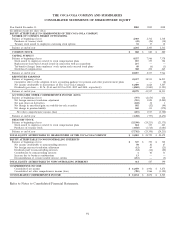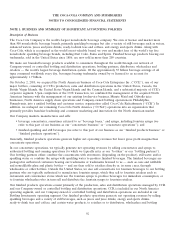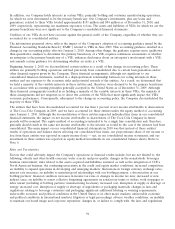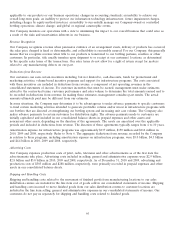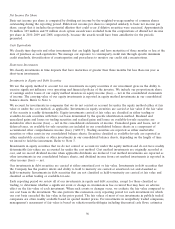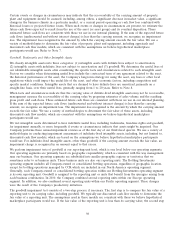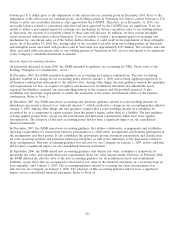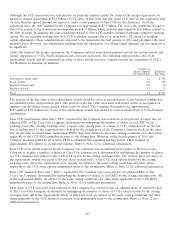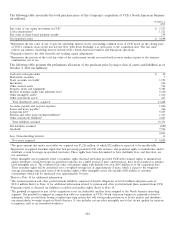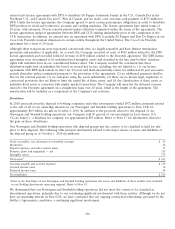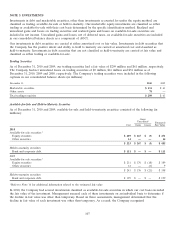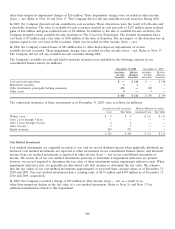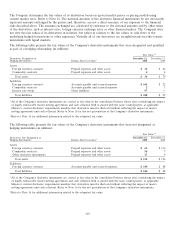Coca Cola 2010 Annual Report Download - page 103
Download and view the complete annual report
Please find page 103 of the 2010 Coca Cola annual report below. You can navigate through the pages in the report by either clicking on the pages listed below, or by using the keyword search tool below to find specific information within the annual report.bolivars per U.S. dollar prior to the elimination of the official rate for essential goods in December 2010. Prior to the
elimination of the official rate for essential goods, our bottling partner in Venezuela was able to convert bolivars to U.S.
dollars to settle our receivables related to sales approved by the CADIVI. Therefore, as of December 31, 2010, our
receivable balance related to concentrate sales that had been approved by the CADIVI was not significant. If we are
unable to utilize a government-approved exchange rate mechanism for future concentrate sales to our bottling partner
in Venezuela, the amount of receivables related to these sales will increase. In addition, we have certain intangible
assets associated with products sold in Venezuela. If we are unable to utilize a government-approved exchange rate
mechanism for concentrate sales, or if the bolivar further devalues, it could result in the impairment of these intangible
assets. As of December 31, 2010, the carrying value of our accounts receivable from our bottling partner in Venezuela
and intangible assets associated with products sold in Venezuela was approximately $135 million. The revenues and cash
flows associated with concentrate sales to our bottling partner in Venezuela in 2011 are not anticipated to be significant
to the Company’s consolidated financial statements.
Recently Issued Accounting Guidance
As previously discussed, in June 2009, the FASB amended its guidance on accounting for VIEs. Please refer to the
heading ‘‘Principles of Consolidation,’’ above.
In December 2007, the FASB amended its guidance on accounting for business combinations. The new accounting
guidance resulted in a change in our accounting policy effective January 1, 2009, and is being applied prospectively to
all business combinations subsequent to the effective date. Among other things, the new guidance amends the principles
and requirements for how an acquirer recognizes and measures in its financial statements the identifiable assets
acquired, the liabilities assumed, any noncontrolling interest in the acquiree and the goodwill acquired. It also
establishes new disclosure requirements to enable the evaluation of the nature and financial effects of the business
combination. Refer to Note 2.
In December 2007, the FASB issued new accounting and disclosure guidance related to noncontrolling interests in
subsidiaries (previously referred to as ‘‘minority interests’’), which resulted in a change in our accounting policy effective
January 1, 2009. Among other things, the new guidance requires that a noncontrolling interest in a subsidiary be
accounted for as a component of equity separate from the parent’s equity, rather than as a liability. The new guidance
is being applied prospectively, except for the presentation and disclosure requirements, which have been applied
retrospectively. The adoption of this new accounting policy did not have a significant impact on our consolidated
financial statements.
In December 2007, the FASB issued new accounting guidance that defines collaborative arrangements and establishes
reporting requirements for transactions between participants in a collaborative arrangement and between participants in
the arrangement and third parties. It also establishes the appropriate income statement presentation and classification
for joint operating activities and payments between participants, as well as the sufficiency of the disclosures related to
those arrangements. This new accounting guidance was effective for our Company on January 1, 2009, and its adoption
did not have a significant impact on our consolidated financial statements.
In September 2006, the FASB issued new accounting guidance that defines fair value, establishes a framework for
measuring fair value, and expands disclosure requirements about fair value measurements. However, in February 2008,
the FASB delayed the effective date of the new accounting guidance for all nonfinancial assets and nonfinancial
liabilities, except those that are recognized or disclosed at fair value in the financial statements on a recurring basis (at
least annually), until January 1, 2009. The accounting guidance related to recurring fair value measurements was
effective for our Company on January 1, 2008. The adoption of this accounting guidance did not have a significant
impact on our consolidated financial statements. Refer to Note 16.
101


